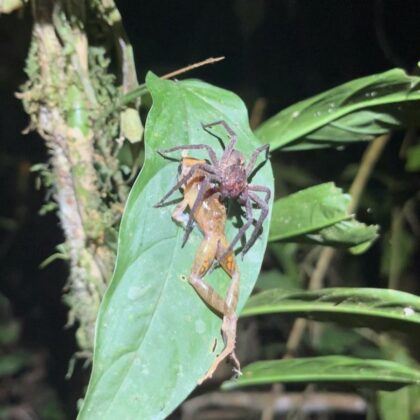At the Manu Learning Centre (MLC), our focus includes the study of herpetofauna, encompassing both amphibians and reptiles. These organisms are excellent bioindicators, meaning that they give us an idea of the health of the environment that they live in. Amphibians and reptiles play a vital role in the food web, as they act as both predator and prey. They simultaneously control populations of animals such as insects and small vertebrates, while supporting populations of their predators.
Recently, we had a rare opportunity to witness a fascinating event: a spider capturing and devouring a Pristimantis reichlei, a small semi arboreal frog in the Craugastoridae family. Since instances of feeding and predation are rarely observed, it is crucial to document them, for example by writing and publishing natural history notes. These types of records contribute towards developing a greater understanding of predator-prey dynamics and the intricacies of rainforest food webs.

One of the MLC’s distinctive inhabitants is the Smooth-fronted Caiman, scientifically known as Paleosuchus trigonatus. These stealthy creatures are commonly found in the streams and wetlands of the MLC, where they prowl during the night.This fearsome creature is close to the top of the food web, with few animals being able to subdue and kill them, such as the jaguar. This means that they are vitally important in controlling populations of their prey species, including fishes, frogs, reptiles, birds, and small mammals. Therefore, if we notice changes in the abundance of these caimans over time, it could indicate greater problems within their environment that affect population dynamics of the animals in the trophic levels below them.
MSc Joseph Oakley – Research Coordinator
